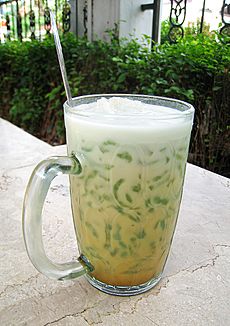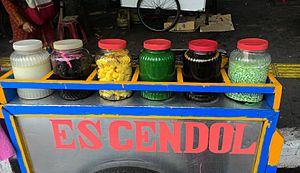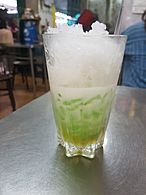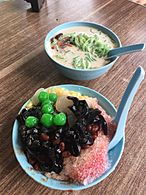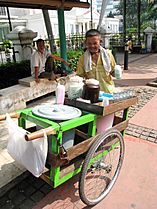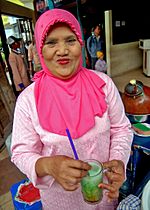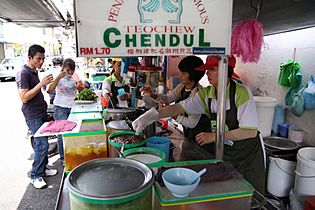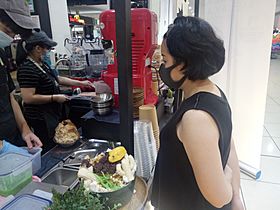Cendol facts for kids
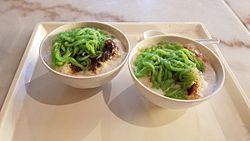
Bowls of cendol
|
|
| Alternative names |
|
|---|---|
| Type | Dessert |
| Place of origin | Southeast Asia |
| Associated national cuisine | Brunei, Cambodia, Indonesia, Laos, Malaysia, Myanmar, Singapore, Thailand, East Timor, Vietnam |
| Main ingredients | Coconut milk, rice flour jelly with pandan leaves juice, shaved ice, palm sugar |
Cendol is a super yummy, cold, and sweet dessert drink. It's made with green jelly noodles, creamy coconut milk, and sweet palm sugar syrup. You can find Cendol all over Southeast Asia, and it's super popular in countries like Indonesia, Malaysia, Singapore, and Thailand.
Sometimes, people add extra yummy things to their Cendol. These can include diced jackfruit, sweet red beans, or even durian fruit. It's a refreshing treat, especially on a hot day!
Contents
What's in a Name?
The word Cendol first appeared in books and dictionaries in the 1800s. Back then, Indonesia was known as the Dutch East Indies. One of the oldest mentions is from an 1866 recipe book called Oost-Indisch kookboek. This book had a recipe for "Tjendol of Dawet," showing these names were used for the same dessert.
In Malaysia, the word "chendol" was first written down in 1932. It was listed as a food you could buy in Kuala Lumpur.
Many people believe the name "Cendol" comes from the word jendol. In languages like Javanese, Sundanese, Indonesian, and Malay, jendol means "bump" or "swollen." This makes sense because the green jelly pieces look a bit like swollen worms!
- In Indonesia, cendol often means just the green jelly noodles. The whole drink with coconut milk and ice is called es cendol (in West Java) or dawet (in Central and East Java).
- In Vietnam, the jelly is called bánh lọt. It's a common part of a dessert drink called chè.
- In Thailand, it's called lot chong, which means "gone through a hole." This describes how the jelly is made by pushing dough through a sieve.
- In Myanmar, it's known as mont let saung.
- In Cambodia, it has names like lot or nom lot.
A Sweet History
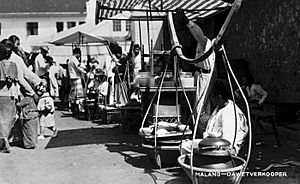
No one knows exactly where Cendol first came from, but it's enjoyed all over Southeast Asia. Some people think it started in Java, Indonesia, as a drink called dawet. The name "dawet" was written in a Javanese book from the early 1800s.
An Indonesian expert even thinks a similar sweet drink might have been mentioned in a 12th-century book from Java! In Java, dawet is the full drink with green jellies (made from sago or rice flour), coconut milk, and palm sugar syrup. Cendol jellies are still made the old-fashioned way in Javanese villages. In some places, like Banjarnegara, dawet was traditionally served without ice. But today, everyone loves it with ice!
Cendol has changed a bit in different countries:
- In Indonesia, cendol usually means just the green pandan jelly served in coconut milk. Sometimes, pandan leaves or jackfruit are added.
- In Malaysia and Singapore, cendol often includes other things like sweet red beans or sweet corn, making it more like a mixed dessert.
Adding ice to Cendol probably became popular when ice became easier to get. This might have happened in port cities like Malacca and Penang, where British ships with refrigeration technology could bring ice.
Cendol in Traditions
In Javanese culture, dawet or cendol is part of traditional wedding ceremonies. There's a special event called dodol dawet (which means "selling dawet") the day before the wedding. After a special bridal shower, the parents pretend to sell dawet to their guests. Guests pay with special terracotta coins, which are then given to the bride. This symbolizes the family's earnings and is a wish that many guests will come to the wedding, "as plenty as the cendol jellies being sold."
Long ago, in Java, you could often see street vendors selling dawet from baskets carried on a balancing pole, just like in old photos from the 1930s.
The Indonesian government has even recognized five different ways of making Cendol as important cultural heritage! Malaysia has also declared Cendol a national heritage food.
What's Cendol Made Of?
The main ingredients for Cendol come from sugar palm and coconut trees. The basic Cendol has:
- Coconut milk
- Jelly noodles made from rice flour
- Green food coloring (usually from pandan leaves)
- Shaved ice
- Palm sugar syrup
In Indonesia, Cendol is often served in a tall glass. First, the palm sugar syrup goes in the bottom. Then come the green jellies, followed by coconut milk, and finally, a big scoop of shaved ice on top.
The Cendol in Singapore and Malaysia often has sweet red beans added. It's usually served in a bowl instead of a glass. The dark palm sugar syrup they use is often called gula melaka.
In Indonesia, especially in West Java, the green jelly noodles are usually made from rice flour. But in traditional Javanese cendol, the noodles were made from sagu aren, which is starch from the sugar palm tree. To make the Cendol noodles nice and chewy, they need the right mix of sago flour and rice flour.
Other things you might find in Indonesian Cendol include tapai (fermented sweet cassava), black grass jelly, and sweetened condensed milk. In Myanmar, mont let saung can be served with a caramel-colored jaggery syrup or with coconut milk. It's a popular snack during their New Year festival, Thingyan. Thai lot chong is simpler, usually just the green jellies, coconut milk, palm sugar, and ice.
Different Kinds of Cendol
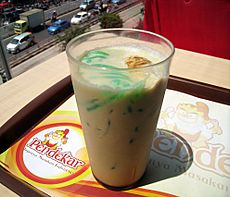
There are many fun variations of Cendol!
- In Indonesia, a famous type is Javanese es dawet ayu from Banjarnegara.
- Another Indonesian variant is black Cendol, called es dawet ireng from Purworejo. Ireng means "black" in Javanese. This black Cendol gets its color from the ash of burned rice stalks mixed with water, instead of green pandan leaves.
Besides the basic ingredients, Cendol can have many extra toppings:
- In Indonesia, popular additions include diced jackfruit, tapai, durian fruit, and chocolate condensed milk.
- In Malaysia, you might find sweetened red beans, glutinous rice, grass jelly, creamed corn, durian, glutinous rice tapai, and even ice cream!
Some newer versions of Cendol have appeared, like Cendol with vanilla ice cream or even a "Cendol latte," which mixes Cendol with coffee!
Where to Find Cendol
Cendol is a classic dessert in Southeast Asia. You can often buy it from street vendors, at food stalls in markets, or in big food courts. In Indonesian cities like Jakarta, Bandung, and Yogyakarta, you'll see Cendol vendors almost everywhere.
Originally, Cendol in Java was served without ice. But once refrigeration technology became common, cold Cendol with shaved ice became super popular.
In Indonesia and Malaysia, Cendol is commonly sold by vendors on the side of the road. In Singapore, you can find it in dessert stalls, food centers, coffee shops, and food courts. It's a favorite treat for many!
-
Roadside cendol vendor in Jakarta.
-
Dawet seller in Solo, Central Java.
-
A stall selling cendol in Penang, Malaysia.
-
Cendol Melaka with Durian selling in Johor Bahru, Malaysia Shopping Mall.
Cendol in Pop Culture
On an Indonesian internet forum called Kaskus, the word "cendol" is used as a positive rating! If someone likes an online post, they give it a "green cendol." A negative rating is called a "red bata" (brick).
In 2018, Cendol caused a bit of a friendly debate when CNN listed the Singapore version as one of the world's top 50 desserts. This made some Malaysians playfully upset, as they also claim Cendol as their own!
See also
 In Spanish: Cendol para niños
In Spanish: Cendol para niños


